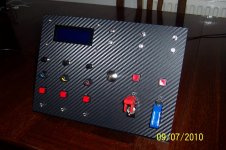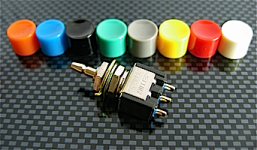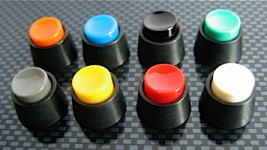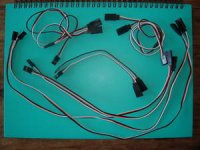okay First part of the tutorial

First off, we need to think about the design, its size, where its going to go? Desk top mounted, fitted into a dash panel etc. Then its the number of buttons you want to use and the types/styles too.
I use 3mm thick perspex (this can be bought off E-Bay in A4 size approx 300x215mm for around £3 a sheet inc postage). It comes in various colors and or tints. Of course you can use any material you like, but I have found this to be the best for me, its cheap, rigid and easy to cover to a flawless finish! If you are going to make a copy of this one below, you will need two sheets to finish it...

One sheet for the panel its self (uncut A4 size) and one more for the floor and sides of the box. Dont forget you can buy the perspex in diffrent colors AND a nice LIGHT tint or CLEAR that is perfect to show displays through (like my LCD display in the panel above).
Next consideration is the controller, I use a Leo Bodnar BU0836 'joystick' USB interface. Its an excellent bit of kit, cheap, very well made and pretty easy to use too! Check it out here :
http://www.leobodnar.com/ There are a number of diffrent versions available including a rather more expensive no solder one (But I have a very cheap solution to avoid soldering on the board if you dont like fine solder work!! Keep reading the Tuts:tongue

and I would recomend the 'Basic' BU0836 here
http://www.leobodnar.com/products/BU0836/. This board will cope with not just buttons, but rotary encoders and 'POTS' or potentiometers to give them there propper name lol (thease are whats used to measure the movement in say, your pedals) so it can do lots more than just buttons

Next up is buttons, this is very much personal taste, the only real requirement is that they are 'Momentary' switches I.E. Press for ON release for OFF (they DONT stay on when you let go) otherwise voltage/ampage is unimportant!:tongue: E-Bay again is favorite for a bargain, but be aware, you get what you pay for! Very cheap buttons/switches tend to be just that, CHEAP n NASTY. A fairly easy way to look at the quality of a switch visually is to look at the body, if its all plastic, its probably cheap and also look at the solder tags where the wires go on, if they are just plastic, again be careful, but if you can see they are 'epoxyed' in place this is a good sign that they are high quality and wont melt the second the soldering iorn goes near them lol!
Again, Leo Bodnar sells excellent quallity switches such as the knitter ones I have used for some of my 'wheel' switches, but at about £8 each, cheap they are not!


Top quality knitter switches, easily the best!

Leo's Bu0836 USB board
Rotary Encoders: Think of these as rotary switches, but digital, only needing 3 wires. The Board see's them as two switches in effect. Turn the knob to the right and it see's it as one button press (i.e button 2 for example that you have 'mapped' for brake bias front) each click you turn to the right, it see's as another 'press' of the button moving the bias further forward. Turn the knob left and its button 1 (mapped for bias rear) Make sense???? Each encoder will use two button inputs. They are pretty cheap and top quality from Leo (I'm not promoting his stuff or on a backhander here lol, just hes got it in stock, right price, will deffo work with his board and good service ) pic below:

Rotary encoder CTS 288 model 288T232R161A2 from Leo Bodnar
Okay, thats about it for part one, lets do a quick recap and parts list:
1) box material: 2x A4 sheets of 3mm thick Perspex
2) controller: BU0836 From Mr Bodnar
3) switches, momentary type
Ask any and all questions on the '
button box' thread and get thinking about your design, type/number of switches, where you want to place them on the panel etc
















